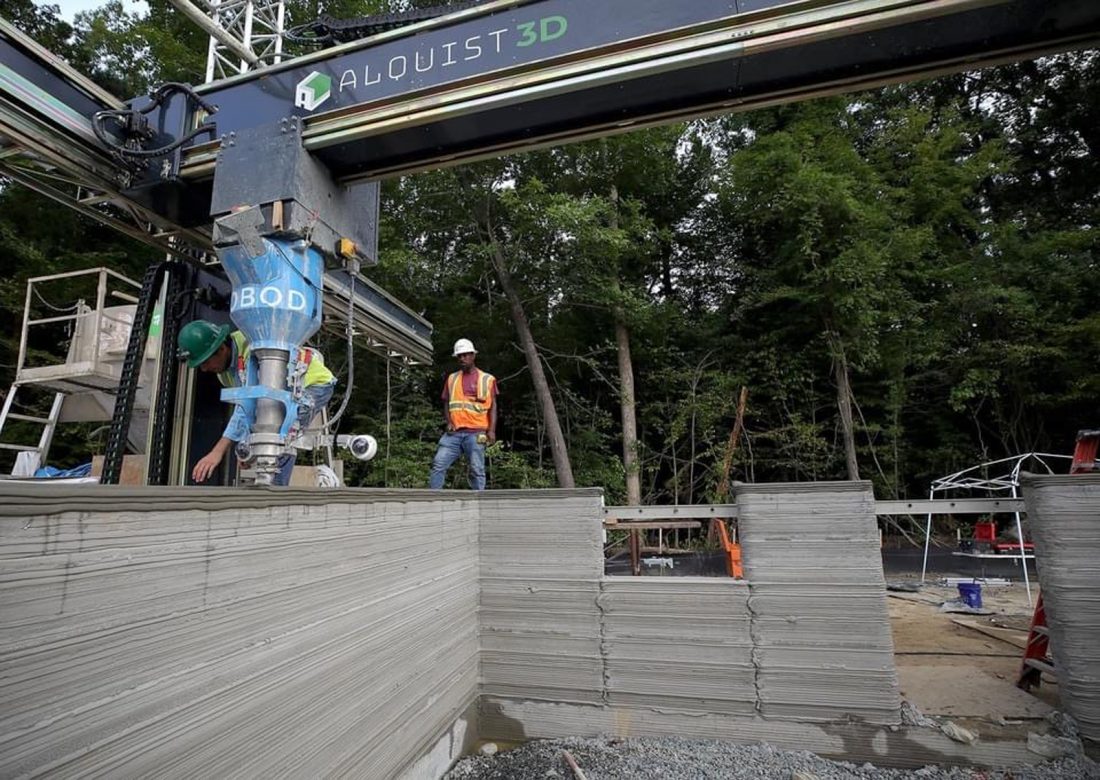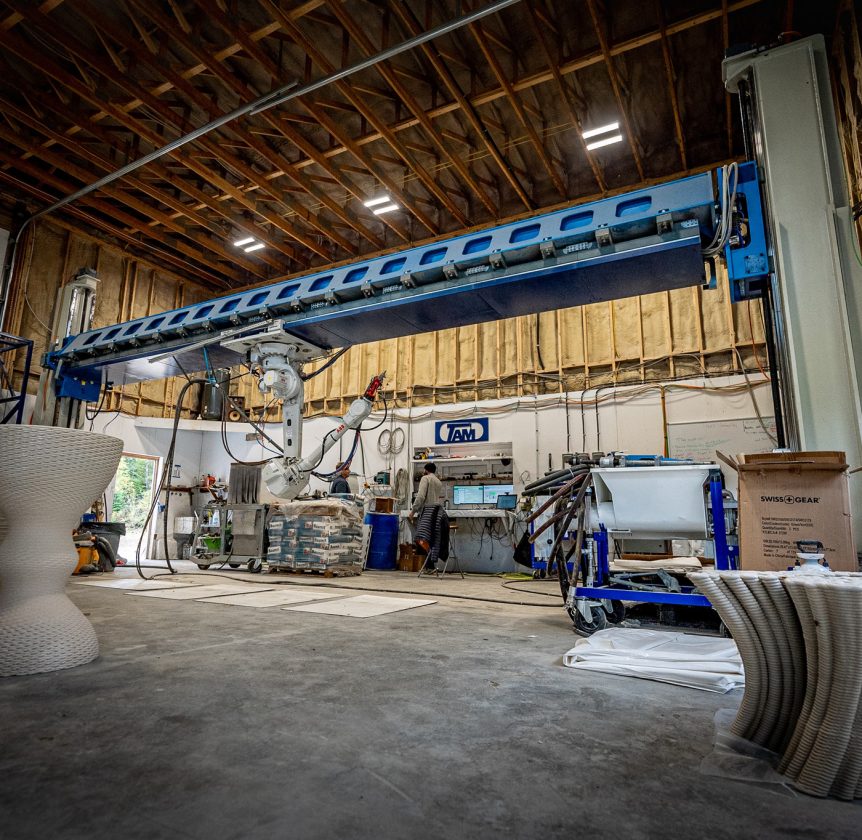‘No boundaries’
ISU, Iowa Central partnership will put 3D printing to the test; Technology will be used to build homes
-
-Submitted photo
Alquist3D, an Iowa-based company, uses its 3D printer to construct the walls of a home in Virginia. The keys to the home were handed over last week, according to Pete Evans, assistant professor in the industrial design department at Iowa State University. Alquist3D will be partnering with Iowa State and Iowa Central Community College on its new 3D house printing program.
-
-Submitted photo
An industrial-sized 3D printer like the one pictured will eventually be used by students at Iowa Central Communty College. Iowa Central is partnering with Iowa State University on a 3D printing program.

-Submitted photo
Alquist3D, an Iowa-based company, uses its 3D printer to construct the walls of a home in Virginia. The keys to the home were handed over last week, according to Pete Evans, assistant professor in the industrial design department at Iowa State University. Alquist3D will be partnering with Iowa State and Iowa Central Community College on its new 3D house printing program.
Imagine an industrial-sized 3D printer that pours concrete like frosting on a cake. The machine lays the concrete layer by layer, and when it’s finished, a strong, suitable home is standing.
This type of autonomous technology could be the answer to Iowa’s housing shortage. And a new partnership involving Iowa Central Community College and Iowa State University aims to find out.
The Iowa Economic Development Authority board recently approved a $1.4 million grant to Iowa State University’s College of Design for the 3D Affordable Innovation Technologies Housing Project, which will support the development of a 3D printed housing industry in Iowa.
As part of that effort, Iowa Central will house a new state-of-the-art 3D printer in the coming months at its East Campus, 2031 Quail Ave. Starting in the fall of 2023, Iowa Central will begin training students to use the new technology through its carpentry program.
“Iowa State will provide this (3D printer) and a lot of the research and development,” said Dan Oswald, Iowa Central carpentry instructor. “Iowa Central’s role will be to train the workforce for it. This will actually be putting boots on the ground for the technology ISU is testing.”

-Submitted photo
An industrial-sized 3D printer like the one pictured will eventually be used by students at Iowa Central Communty College. Iowa Central is partnering with Iowa State University on a 3D printing program.
Pete Evans, assistant professor in the industrial design department at Iowa State, is leading the project. Evans, an architect, said the 3D printing application could speed up the building process.
“This new 21st century technology will revolutionize the residential building industry,” Evans said. “We are trying to, through a multi stakeholder partnership, make sure that disruption to the industry is as smart for the state of Iowa and its citizens as we can prepare.
“It’s not just getting a machine and going and doing something, it’s going to be something where we build up the ecosystem around that to support multiple technologies so the workforce is prepared to work with that technology as best we can anticipate.”
3D PRINTING HAS BEEN AROUND for decades, according to Evans. However, only in relatively recent times has it been used for large scale projects like building a house.
“It’s not something that’s been able to scale up outside of a laboratory until about eight or nine years ago,” Evans said. “Seven or eight years ago, there were commercially available small plastic printing machines that you could go out and buy. Today those machines are all over the place. You can go out and buy on Amazon and build them yourself. People are doing that like crazy.
“But the technology for scaling this to housing really started in 2014 or 2015 in China, I believe. It’s taken this long to cross different countries and companies to be able to start to be viable. I think the first examples started showing up in Minnesota four or five years ago, but housing technology, only a year or two. We aren’t slow to the starting line here. It’s a pretty new application.”
Leaders from Iowa Central and Iowa State met over the summer to discuss a potential partnership.
Oswald and Bill McAnally, high performance building consultant and former Iowa Central instructor, attended the meeting co-hosted by Iowa State University College of Design and the Iowa Economic Development Authority on June 18 at the Student Innovation Center located on the ISU campus in Ames. High performance building methods were discussed during the meeting.
McAnally realized that Iowa Central would be able to provide logistics, housing of the printer, maintenance, programming and construction assistance.
“We wanted Iowa Central to be the first in this state to do this type of project,” McAnally said.
Jesse Ulrich, president of Iowa Central, saw it as a great opportunity for the college.
“As Iowa Central continues to be a leader in providing workforce solutions, this partnership with Iowa State will allow us to expand our degree opportunities for students,” Ulrich said. “It will also provide our students with the opportunity to make a positive difference by providing affordable housing for communities across the state of Iowa.”
Neale Adams, Iowa Central dean of business and industrial technology, believes autonomy will continue to reshape the construction industry.
“We want to make sure we are educating students for the jobs that are going to be available for them in the future, not always what’s in front of them right now,” Adams said. “They need their basic construction skills. They need to be able to know how a house is put together. But just like in manufacturing, automation and robotics has picked up. Robotics is commonplace in manufacturing and we feel that in the future it will probably be commonplace in the construction industry as well. If we don’t meet these students’ needs of what the industry is going to, then we are not serving them in the educational fashion we should.”
ONE OF THE FIRST STEPS will be acquiring the 3D printer. Evans said it will take between four and eight months to order, acquire and test the machine.
The estimated cost of an industrial-sized 3D printer is at least $500,000, Evans said.
The project is receiving funding from multiple sources including state and federal grants.
McAnally, who has over 40 years of experience in the construction industry, feels a sense of urgency for Iowa and the U.S. to evolve in its building methods.
“We really need to do this type of technology and training to keep up with the rest of the world,” McAnally said. “Europe and Canada seem to be ahead of us on construction technologies. We need to step it up a little. Build homes that will be 100 year homes at least.”
Anywhere from 15 to 40 students typically enroll in the carpentry program at Iowa Central per semester. This past semester started with 18 students.
The opportunity to work with cutting edge technology could attract more students to the program.
“They are more excited about working with technology,” McAnally said. “I think that excitement will kick in. When you see a 3D printer, the first thing you think is, ‘There’s no boundaries.’ You can do anything you want. With houses, there’s no limits.
“I would think architects would just be so excited because you aren’t held down by constraints of materials being certain widths or thicknesses or shapes. You can do anything you want.”
McAnally is impressed by how accurate 3D printing has become.
“One of the big things is the accuracy of this machine,” he said. “You can adapt to surroundings or what particular designs are required for that area.
“With a pumper truck, there are like 10 people out there running rakes and trying to get it level. You do your best, but unless you bring in something like this or a laser level, it’s up to the skills of the worker.”
THE SPEED AT WHICH A HOUSE can be constructed using 3D printing technology is something to behold. That speed could prove useful for communities impacted by natural disasters.
Some companies claim they can print a 1,900-square-foot home in under 48 hours. That’s something Iowa State and Iowa Central will be putting to the test.
“This would be a type of construction that could be done rapidly,” Evans said. “Being able to print recovery housing. We are in a world where how we impact the community and material world is something we need to be careful about. This is a type of construction that could be done rapidly in case of disaster. We are trying to do this with the affordable housing concept as our central tenant.”
Evans said the college’s first demonstration project will be completed in Hamburg, a town of less than 2,000 people in southern Iowa. Hamburg has been affected by extreme flooding in recent years.
Brunow Contracting, of Council Bluffs, and BNIM Architects, of Kansas City, will be working on the Hamburg project.
Projects like that one will allow ISU to measure how effective 3D printed houses are.
“There are some claims about effectiveness and efficiency that we are going to test to make real for Iowa to make sure this is an appropriate solution,” Evans said. “It’s important to understand that this is in place of other technologies like framing and we need to be able to see this side by side with that or other efficient types of construction like structurally insulated panels.”
The hope is that 3D printing will be a game-changer in an industry facing numerous challenges.
“Iowa and the U.S. has a housing shortage,” Evans said. “This is trying to find ways to meet workforce needs and community needs for housing that is affordable. There’s a need to try and turn every stone we can to improve that process. The 3D construction printing and other 21st century technologies we are going to look at will hopefully prove to make a better case for affordable housing here in Iowa directly.”






